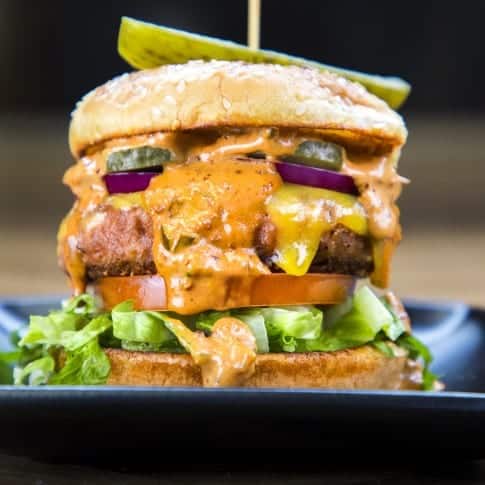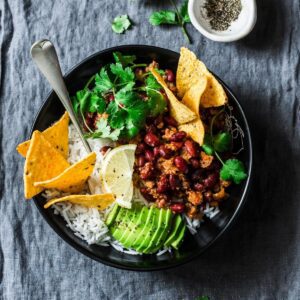Why eating a Beyond Burger is better for the planet than eating a cow burger.

A recent peer-reviewed study at the University of Michigan’s Center for Sustainable Systems found that a ¼ pound plant-based Beyond Burger uses significantly less resources and emits less greenhouse gases than a ¼ pound beef burger. This includes grass-fed beef.
How much less? Are you ready for this? The Beyond Burger uses:
- 99 percent less water
- 93 percent less land
- 90 percent fewer greenhouse gas emissions
- 46 percent less energy
To help us grasp this even more, Beyond Meat’s spokesperson says “On average, Americans eat three burgers a week.
If they switched just one of these beef burgers to a Beyond Burger for a year, it would be like taking 12 million cars off the road and saving enough energy to power 2.3 million homes.” Wow……
The study was commissioned by Beyond Meat (more on this in a second) which is a plant-based meat alternative company.
Their Beyond Burger is the first vegan burger to look and taste eerily similar to a beef burger. It even ‘bleeds’….. weird, I know.
What is the Beyond Burger made of?
The Beyond Burger is soy free and is made mostly of pea and mung bean protein with oil and potato starch and flavorings.
The burger is being marketed to meat eaters that love the taste of meat, but might want to cut down on their environmental footprint and animal suffering.
It’s even being sold in the meat case section and provides more protein and iron than a beef burger, with zero cholesterol.
Let’s take a closer look at this study. I’m always extremely skeptical of such glowing results from an industry-funded study.
It’s important to look deeper at the way the research was performed to see how reliable the information is.
The study compared the Life Cycle Analysis results - the amount of energy, water, green house gas emissions and land used in the making - of a ¼ pound Beyond Burger with that of a ¼ pound beef burger.
The environmental impact results of the ¼ beef burger came from the National Cattlemen’s Beef Association’s own study that they commissioned In 2017.
Beyond Meat used the same analysis techniques as the National Cattlemen’s study.
The study was also independently peer-reviewed before it went out. Meaning, they had a scientific third party objectively take a look at it.
This is an important step, as many industry-funded studies will use watered-down research, skip this part (because a third party can easily see through this) and jump right into sending the results to the press.
That’s why we have so much conflicting nutritional information leaving people purposely confused. After all, confused people won’t upset the status-quo.
Why is meat so damaging to the environment? Why does it take so much energy and resources to produce?
- There are over 3X more livestock animals on this planet than humans.
- Livestock eats 7x more grain than all of the human population combined
- Livestock provides just 18% of our calories but takes up 83% of farmland
- Farm animals produce 13x more waste than humans in the U.S
- Most soybeans & corn grown in the U.S are fed to livestock (all that land is inefficiently being used to feed livestock instead of humans)
- Eating a plant based diet requires 76% less land and 80% less water
- Animal agriculture is responsible for 18% of greenhouse gas emissions. This is more than all of transportation (13%) combined
- Cows produce 150 billion gallons of methane per day which is 25-100 times more destructive than CO2.
The study also showed that Beyond Meat could make their company even more eco-friendly by using renewable and recycled packaging.
This would be in addition to strategies they’ve implemented like installing solar tubes at their headquarter and a water recirculation systems at their Missouri production facility.
On a related note, The Inter Governmental Panel on Climate Change (a group of 91 scientist from 40 countries) recently reviewed 6000 scientific studies and concluded that a climate crises could be closer than we thought (by the year 2040) if we don’t drastically reduce our emissions within a few short years.
This includes extreme food shortages & wildfires, more intense storms and a major die-off of coral reefs. They estimate the total damage of this would be about $54 trillion.
The reduction would have to be even more than what was agreed upon at the 2015 Paris climate summit. This is extremely frustrating given that our current administration is running full speed in the opposite direction.
I know, it’s such doom and gloom. It can seem terrifying, daunting and make us feel helpless and want to hide under the covers. I understand. But, there is hope and there is plenty that we can do.
Some suggest incorporating a carbon tax, developing carbon and methane capture technology and limiting the amount that factories can emit. These are all valid actions we should take as a whole, but they don’t feel like they’re in our hands and as immediate as we need them to be.
Yes, we should stay politically informed and active by calling and voting out the leaders in power. Leaders that are in the pockets of industries that don’t have our health and the environment in mind.
We should approach climate change from every possible angle. We can eat more plant-based while also tackling socio-political issues and reducing our daily emissions.
We can and should take personal steps like reducing our travel emissions, using less plastic, recycling and taking shorter showers, but the choice that makes more of a difference than ALL OF THESE COMBINED is what we choose to eat.
What we eat has one of the biggest effects on the planet. Each time we buy a plant-based product, we’re voting loud and clear for businesses to invest in more eco-friendly products.
If you don’t feel like politicians are hearing you, rest assured that what you vote on with your money speaks incredibly loud. Plant-based product sales increased by 20% in 2018 alone, which in turn has sparked companies to provide more and more options.
Switching to a plant based lifestyle doesn’t have to mean basing your diet on meat alternative and packaged food.
They’re good for transitioning and for satisfying the occasional cravings down the road. Cutting down/out animal products can be as cheap or expensive as you’d like.
If having a Beyond Burger is out of your budget, some of the cheapest foods are still plant-based: rice, beans, grains, fruits and vegetables.
There are many tasty bean and grain burger recipes. Honestly, the condiments are what really make a burger taste like a burger.
Each meal, you can choose to cut your carbon footprint in half just by choosing food made from plants.
If you want to satisfy your craving for a beef burger and also cut back on your environmental destruction, delicious products like the Beyond Burger that are as satisfying as a beef burger, make the choice to protect the environment that much easier and painless.






Leave a Reply